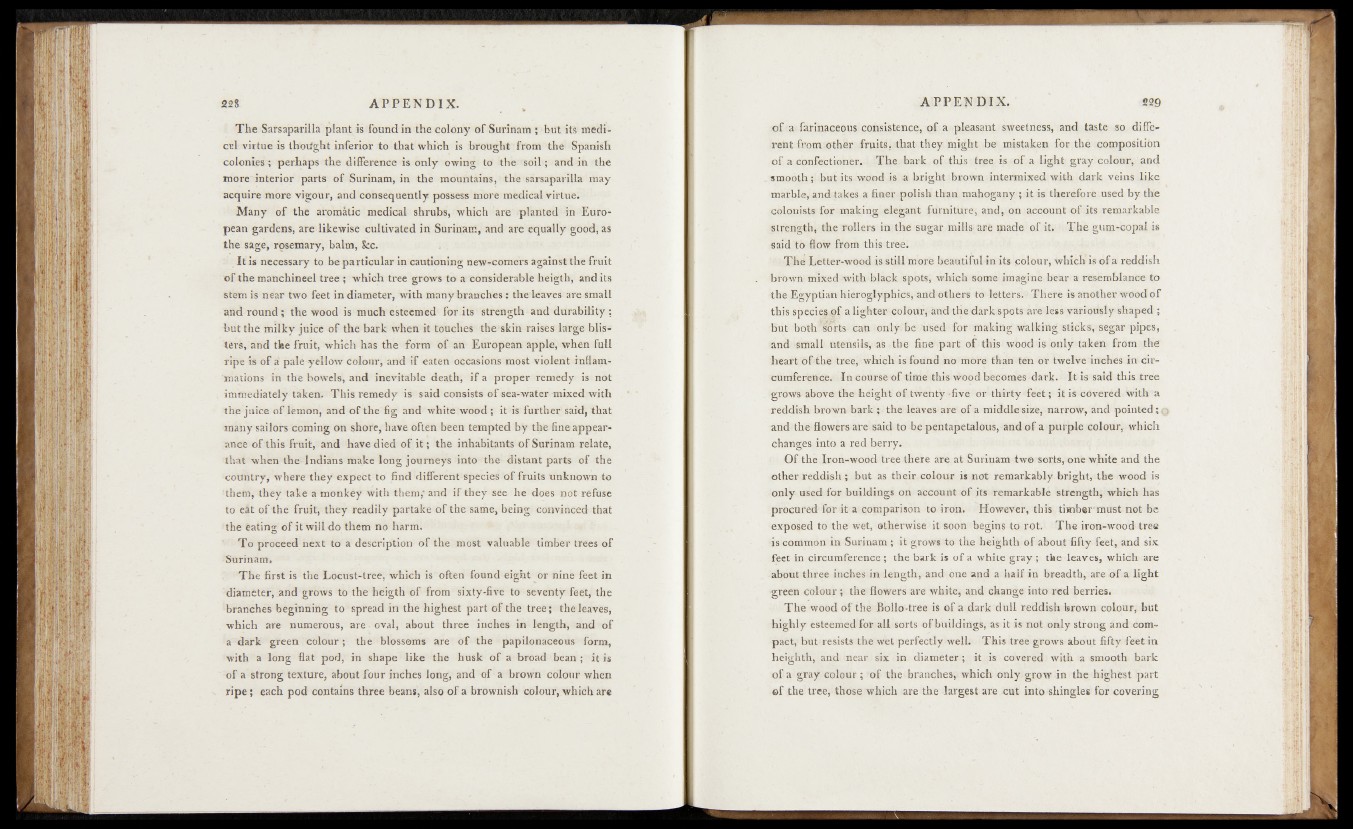
The Sarsaparilla plant is found in th©«olöi^ of Suritfam ;T 1 butits xnedi-
cél‘ virtue is thotfght inferior to that which is broughtfrom the Spanish
colonies; perhaps the difference is only owing to the ^soihj' and-in -the
more- interior parts of Surinam, in the mountains, the sarsaparilla may
acquire more vigour, and consequently possess more medical virtue.
Many of the aromatic medical shrubs, which are planted in European
gardens, are likewise cultivated in Surinam, and are equally good, as
the sage, rosemary, balm, See.
It is necessary to be particular in cautioning new-comers against the fruit
o f the manchineel tree ; which tree grows to a considerable heigth, aud its
stem is near two feet in diameter, with many branches: the'leaves' are small
and round; the Wood is much esteemed for.its strength and durability':
but the milky juice of the bark when it touches the *skih raises large blisters,
and the fruit, which has the form of an European apple, when full
ripe is Of a' pale yellow colour, and if eaten occasions most violeiit inflam-
‘mations in the bowels, and inevitable death, if a proper remedy is* nét
immediately taken. This remedy is said consists of sea-water mixed with
the juice of lemon, and of the fig and white wood ; it is further7said, that
many sailors coming on shore, have often been tempted by the fine appearance
of this fruit, and have died of it; the inhabitants of Surinam relate,
that when the-Indians make long jonmeys into the- distant parts of the
country, where they expect to find different-species of fruits unknown to
‘them, they take a monkèy with them,“ and if they-Sfie he does not refuse
to eSt qf”the fruit, they readily partake of the same, being eonvincedrthat
'the eating' of it will do them no harm.
' To proceed next to a description o f the most valuable’ timber trees of
Surinam,
7 'The first'is ‘ the Locust-tree, which is often found eight or nineffeet in
diameter, and grows to the heigth o f from sixty-five to seventy feet, the
‘branchés beginning to spread in the highest part of the tree; the leaves,
which are numerous, are -oval, about three inches in length, and ©f
a dark green' colour; the blossoms are ö f the papilonaceous form,
with a long flat pod, in shape-like the husk of a broad bean; it is
o f a strong texture, about four inehes long, and of a brown colour when
ripe ; each pod contains three beans, also of a brownish colour, which are
o f ^aTariimce0U S ) C U È ^ i j | e n . C f , sweetness, and taste so different
from other .fruitSfithat tbey might be mistaken for the coropositibn
©E a confectioner. .* The.'terk,,1of .-this'si|^^:'%;.:.kpf>a light gray, colour, 'and
smqétfï 5* bufcjfts*.w© ®d is a bright brown intermixed with dark veins dike
marble, and4akes a finer polish than mahogany ; it is therefore used by the
colonists for making eleg»ant 'furniture; and, on account of its remarkable
strength, Che rollers in the sugar mills arê made of it. The gum-copal is
said tb fhrw frèm this treél 1 •
Thé Letter-wood is -stjlliBÜüi: beautiful in its colour, whiclris of a reddish
brown mixed «with black spots; which some imagine bear a resemblance to
■the E^ptiattfhiérto^ypbies,end!ifchérS tö’tetérsif There is another wood of
thfs.spee|es#| a lightemcqlourj andt% dark,s>pQtsiare~:less varièdsly shaped ;
böt hodKsarts:ean i6nly^# m*sed fo f making'Walking JSrtllcsir Segar pipes,
•and -small utensilsyas the fio© part' ef rthis- wbodis nuly taken from the
heart öftthe‘tree, which is found nu more than ten ©r iwel^ednehes in circumference.
-In course of time this #öod becomes dark. It* is said this tree
-grèws above the h é^ h f of twenty five or thirty feet; it is eéverèd Witfo a
reddish brown bark ; % the leaves < are of a nliddle!size, narrow, and pointed;
and the flowers are said to be pentapetalous, and of a purple colour, which
d^nges-into a red.berry.;
I Of the Iron-woöd tree there are.at Surinam two sorts,>«nfe white and the
other réddishi but as their.colour is nut remarkably, bright,itfae wood as
only-used for buildings on account o f its ^remarkable strength; which has
procured fer dt a qomparison to iron. However, this timber'must not be
exposed to jthe wet, otherwise it söoto begins tö rotit The iTOn-wood'tree
is common in Surinam ; it grows to the heighth of about fifty feet, and six
feet in circumference; the bark is of a white gray; the leaves, which are
about three inchesdn length, and one and a half in breadth;.ate o f a light
green colourthe flowers are white, and change intoredberries.
The wood of the Bollo-tree is of a dark dull reddish brown colour, but
highly esteemed for all sorts of buildings, as it is not only strong and compact,
but* resists the wet perfectly well* This tree grows about fifty feet in
heighth, and near six in diameter; it is covered with a smooth bark
of a gray colour ; *nif the branches^which onlyigrow in the; highest ipart
©f the tree, those which are the largest are cut into shingles for covering